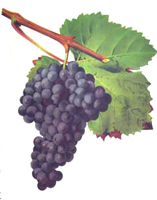Those seeking a longevity-boosting
tipple should turn their attention to red wines from Sardinia
and south-west France, a study by UK researchers has concluded.
 Chemicals
called procyanidins are responsible for red wine's well-documented
heart-protecting effect, concludes the study by Dr. Roger
Corder. It also adds that the traditionally made wines from
these areas had more procyanidins than wines in other parts
of the world. Chemicals
called procyanidins are responsible for red wine's well-documented
heart-protecting effect, concludes the study by Dr. Roger
Corder. It also adds that the traditionally made wines from
these areas had more procyanidins than wines in other parts
of the world.
Previous studies have revealed regular,
moderate consumption of red wine is linked to a reduced
risk of heart disease and lower mortality.
A class of chemicals called polyphenols,
of which there are many varieties, are thought to be responsible.
Using endothelial cells (cells that line the vascular system),
the researchers pinpointed polyphenols called procyanidins
as those that provided the most potent protective effect.
They then tested red wines from around
the world to measure their levels of procyanidins, including
wines from Nuoro province in Sardinia and
the Gers region of the Midi-Pyrenees in south-west
France, areas famous for their population's longevity.
They discovered wines from these regions
had on average between two and four times
the level of procyanidin compared with wines from countries
including Spain, Australia, South America and the US.
Traditionally made
Professor Roger Corder, from the William
Harvey Research Institute, at Queen Mary, University of
London, said: "There is a 19th Century expression:
'A man is only as old as his arteries', which can be taken
to mean that those with the healthiest arteries live longer.
"So it was of great interest to us
when we found both in Sardinia and in south-west France
that the wines made in these in areas had higher levels
of procyanidins."
The researchers believe the way that wines
are made is the key.
In traditional wine making, said Professor
Corder, grapes have a three to four week fermentation period,
allowing for full extraction of the chemical from the skin
and the seed.
Modern-style wines are only fermented
for a week, resulting in little or no procyanidin.
 |
Tannat: Tough and Tannic Tonic from Uruguay |
He added that the grape was also important
and the tannat, cabernet sauvignon
and Nebbiolo grapes made procyanidin-rich
wines.
Professor Corder said: "The traditional
production methods used in Sardinia and south-western France
ensure that the beneficial compounds, procyanidins, are
efficiently extracted.
"This may explain the strong association
between consumption of traditional tannic wines with overall
wellbeing, reflected in greater longevity."
Cathy Ross, cardiac nurse at the British
Heart Foundation (BHF), said: "While we have known
for some time that a moderate amount of alcohol can help
to reduce your risk of developing heart disease, we would
not recommend anyone to start drinking. Those who do enjoy
a tipple should keep within the recommended levels. http://newsvote.bbc.co.uk
 Dr.
Roger Corder who had earlier written a book called, 'The
Wine Diet' has written another book- 'The Red Wine Diet'
which is to be released on 6th September, 2007 Dr.
Roger Corder who had earlier written a book called, 'The
Wine Diet' has written another book- 'The Red Wine Diet'
which is to be released on 6th September, 2007
Tannat grape was taken to Uruguay in
1860 by a French Basque called Don Pascual Harriague. From
there it found its way to Argentina. It made its presence
in California in 2000 and is expected to grow in popularity
due to the health benefits. The grape has done very well
in South America and though the use in France has been coming
down, the acreage is increasing in South America. More than
a third of Grapes grown in Uruguay (36%) constitute Tannat.
The highly tannic grape is mellowed
down by blending it with Merlot, Pinot Noir and Cabernet
Frank although single varietal is also quite popular, especially
as a Reserve wine. A Bordeaux blend using Cabernet Sauvignon,
Merlot, Cabernet Franc with Tannat also makes delicious
wine- Editor
|